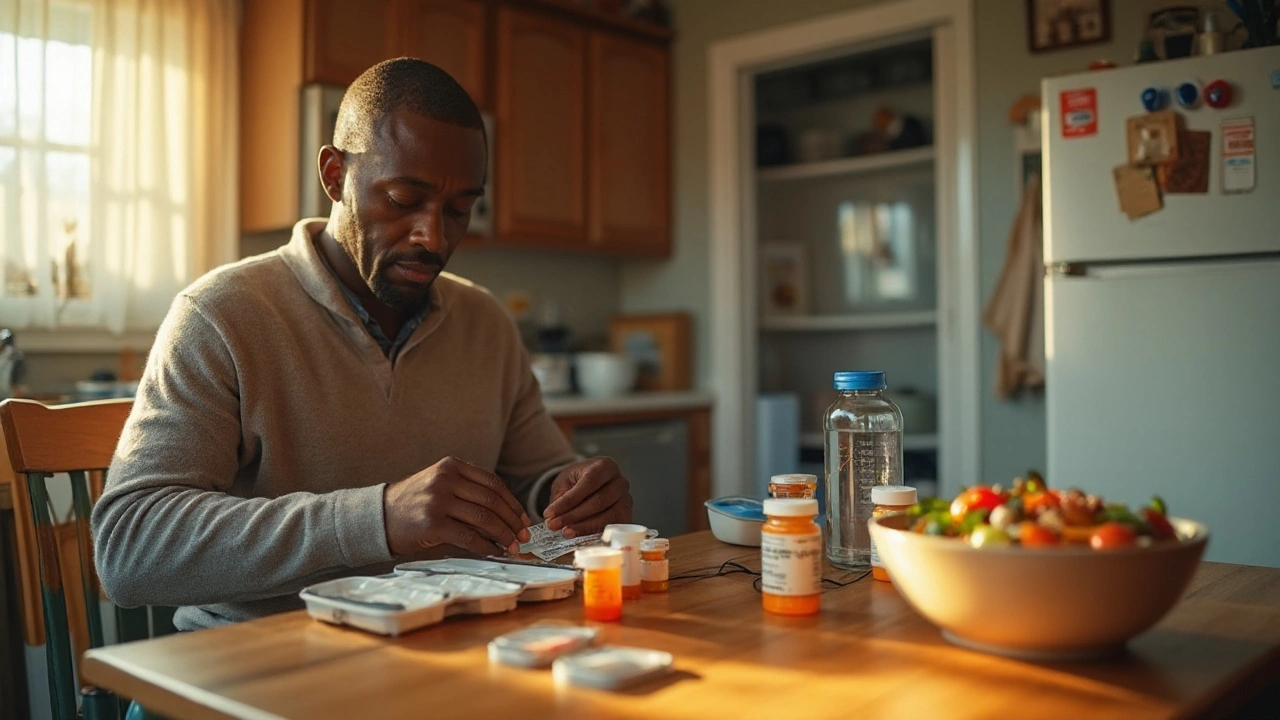Heart failure doesn’t just tire your heart; it quietly strains your kidneys too. That combo-doctors call it cardiorenal syndrome-drives swelling, breathlessness, and repeat hospital trips if you miss the early signs. This guide gives you a plain‑English map: the heart-kidney link, which tests matter, how meds and fluids fit together, and clear “what to do when” steps.
If you live with chronic heart failure or care for someone who does, expect a few key shifts: daily weight checks, smarter salt and fluid choices, a basic understanding of labs, and a simple plan for sick days. Nothing fancy-just steady, practical habits that prevent the spirals that lead to the ER.
TL;DR
- Heart and kidneys work as a team. When the heart can’t pump or pressure backs up, kidney function dips-this is cardiorenal syndrome.
- Labs and numbers to watch: creatinine/eGFR, potassium, sodium, urine albumin‑to‑creatinine ratio, daily weight, blood pressure, and symptoms.
- Small creatinine bumps after starting ACE/ARB/ARNI or SGLT2 meds can be expected; your team will recheck labs in 1-2 weeks.
- Daily playbook: consistent loop diuretic use, sodium around 2 grams/day, fluids about 1.5-2 L/day if advised, and “sick‑day rules” to hold certain meds during dehydration.
- Call your team fast if weight is up 2+ lb overnight or 5+ lb in a week, potassium is >5.5, you’re breathless at rest, peeing much less, or you feel faint.
How heart failure strains your kidneys (and what tests really matter)
Your kidneys filter blood using pressure. Heart failure weakens forward flow (less blood reaches the kidneys) and raises back‑pressure in the veins (congestion). That double hit lowers filtration, so creatinine climbs and eGFR falls. On top of this, your body releases hormones (renin, angiotensin, aldosterone) that hold onto salt and water, which can swell your legs and lungs and push blood pressure around. You feel it as swelling, fast weight gain, and shortness of breath.
Doctors often call this cardiorenal syndrome. In chronic heart failure, the most common patterns are:
- Reduced kidney blood flow from a weak pump or low blood pressure.
- Venous congestion: high pressures back up into the kidneys and liver.
- Medication effects: some drugs protect kidneys long term but can nudge creatinine up short term.
“Heart failure means the heart can’t pump enough blood to meet the body’s needs.” - American Heart Association
What should you actually track at home and in labs?
- Daily weight: weigh each morning after peeing, before breakfast, same scale, same clothing level. Rapid changes often beat labs in warning you about fluid shifts.
- Blood pressure and heart rate: record morning numbers. Bring the log to visits. Low pressures plus dizziness could mean over‑diuresis or dehydration.
- Creatinine and eGFR: core markers of filtration. A small creatinine rise (up to ~30%) after starting ACE/ARB/ARNI can be acceptable and often settles; your clinician will recheck.
- Potassium: many heart meds (ACE/ARB/ARNI, MRAs) and kidney disease push potassium up. High K can cause dangerous heart rhythms. Know your trend.
- Urine albumin‑to‑creatinine ratio (ACR): shows kidney stress early, even when eGFR looks okay. Ask for it at least yearly if you have diabetes or known kidney disease.
- Sodium: low sodium on labs can point to fluid overload and hormone shifts.
Signals to act quickly (call your clinician or seek urgent care):
- Weight up ≥2 lb overnight or ≥5 lb in a week.
- Short of breath at rest, new chest tightness, or waking up gasping.
- Very low urine output compared to your normal, or very dark urine.
- New confusion, severe dizziness, fainting, or chest pain.
- Potassium ≥5.5, or a creatinine jump beyond what your clinician told you to expect.
How often should labs be checked? After starting or changing ACE/ARB/ARNI, MRA, or high‑dose diuretics, many teams recheck creatinine and potassium within 1-2 weeks. If you’re stable, every 3-6 months is common. With diabetes or CKD stage 3-4, expect tighter monitoring. These rhythms follow US guideline updates from ACC/AHA/HFSA and KDIGO through 2024-2025.

Daily management: meds, fluids, salt, and sick‑day rules
Treatment aims to reduce congestion, protect the heart, and protect the kidneys. You’ll see a few medication families over and over. Here’s how they affect the kidneys in day‑to‑day life.
| Medication class | Examples | Kidney effect | Potassium | What you may notice | Call your clinician if… |
|---|---|---|---|---|---|
| ACE inhibitors / ARBs / ARNI | Lisinopril, losartan, sacubitril/valsartan | Protective long term; small early creatinine rise can occur (often OK up to ~30%) | Can raise K | Less shortness of breath over weeks; lower BP | Severe dizziness, K ≥5.5, creatinine jump beyond plan, facial swelling (rare) |
| SGLT2 inhibitors | Dapagliflozin, empagliflozin | Slow CKD progression; fewer HF hospitalizations | Neutral to mild K changes | Slightly more urination; mild drop in eGFR early that stabilizes | Signs of dehydration, genital yeast infection, very low BP |
| MRAs | Spironolactone, eplerenone | Reduce scarring; help HF symptoms | Raise K (monitor closely) | Less swelling; possible breast tenderness with spironolactone | K ≥5.5, worsening kidney function, severe cramps, irregular heartbeat |
| Loop diuretics | Furosemide, torsemide, bumetanide | Remove excess fluid; high doses can stress kidneys if you become too dry | Lower K (especially with high doses) | More peeing; weight drops when fluid leaves | Very low BP, dizziness, minimal urine, ringing in ears (rare, high doses) |
| Thiazide‑type diuretics | Chlorthalidone, metolazone | Add‑on in diuretic resistance; dehydration risk if overused | Lower K and sodium | Big urine output on dosing days | Weakness, confusion, or cramps from low sodium or K |
| Finerenone | Finerenone | Slows CKD with diabetes; heart protection | Can raise K | Usually subtle; lab‑driven | K rising despite dose adjustments |
| NSAIDs (avoid or limit) | Ibuprofen, naproxen | Constrict kidney blood flow; fluid retention | May raise K | Swelling or weight gain | Use alternatives for pain; call before using |
Why SGLT2 inhibitors get so much love: large trials (DAPA‑HF, EMPEROR‑Reduced/Preserved, DAPA‑CKD, EMPA‑KIDNEY) showed fewer heart failure hospitalizations and slower kidney decline, whether or not you have diabetes. ACC/AHA/HFSA and KDIGO guidelines through 2025 reflect this.
About loop diuretics: torsemide and bumetanide are often absorbed more predictably than furosemide, especially if you have gut swelling. Your clinician may switch you if furosemide seems weak. Some patients need a short course of a thiazide‑type diuretic (like metolazone) as a booster. That combo is powerful-and dehydrating if not watched-so teams usually check labs within a week.
Fluids and salt without misery:
- Sodium: a good starting target is about 2 grams (2,000 mg) per day. Read labels. Swap high‑sodium deli meats and soups for fresh protein and frozen veggies. Restaurant meals can be sodium bombs; ask for no added salt.
- Fluids: many people land around 1.5-2 liters/day, but this is individualized. If you’re dry (dizzy when standing, dark urine, low BP), you may need more. If you’re swollen, short of breath, and your weight is climbing, you may need less-for a while. Follow your plan.
- Potassium foods: only cut back if your potassium runs high or you’re on MRAs with rising K. A dietitian can help tailor this.
Sick‑day rules (print this and stick it on the fridge):
- If you have vomiting, diarrhea, high fever, or can’t keep fluids down-risk of dehydration-pause these until eating and drinking normally for 24-48 hours: ACE/ARB/ARNI, SGLT2 inhibitors, MRAs, metformin, and sometimes diuretics if your BP is low and you’re barely peeing. Ask your clinician for a personalized list.
- Keep sipping fluids in small amounts to avoid dehydration unless your team told you to restrict strictly.
- Check weight, blood pressure, and urine output daily. If you’re urinating very little or feel faint, call.
- Restart meds when you’re back to normal intake and your team says it’s safe.
Pain control tip: reach for acetaminophen first, not NSAIDs, for aches-especially if your kidneys are sensitive. If you need anti‑inflammatory relief, ask about topical options or short, supervised courses.

Action plans, checklists, and when to call your care team
You don’t need a medical degree to manage this well. You need a routine, a few numbers, and clear thresholds. Here’s a simple, durable setup.
Daily routine (10 minutes total):
- Morning weight after peeing, before breakfast. Record it.
- Blood pressure and heart rate. Sit for 5 minutes first.
- Quick symptom scan: more shortness of breath? New cough when lying down? Tight shoes or socks leaving deep marks?
- Take meds as scheduled. If a dose change happens, mark the date in your log.
Weekly routine (20 minutes):
- Review trends: is the average weight drifting up? Is BP lower than usual with dizziness?
- Look at sodium intake-what three swaps could cut 500-1,000 mg/day this week?
- Prep questions for your next visit based on your log.
Appointment prep (what to bring):
- Your weight/BP log and med list (with doses).
- Any recent lab results or portal screenshots.
- Two to three specific goals or worries (e.g., nighttime cough, leg swelling by afternoon, confusion about fluid goals).
Rules of thumb that prevent hospital days:
- Weight fast‑track: up 2 lb overnight or 5 lb in a week? Call your care team the same day.
- Diuretic timing: morning or early afternoon to avoid nighttime bathroom trips and poor sleep.
- Hot weather or wildfire smoke days: you may dehydrate faster or work harder to breathe. Pace activity, watch BP, sip fluids as allowed, and check weight daily.
- After any med change that can affect kidneys (ACE/ARB/ARNI, MRA, SGLT2, high‑dose diuretics): plan a lab recheck in 1-2 weeks.
When to involve a kidney specialist (nephrologist):
- eGFR persistently <45, rapid decline, or urine ACR is high.
- Potassium is hard to control despite med adjustments.
- You’ve had repeated hospitalizations for fluid overload or diuretic resistance.
Protective lifestyle moves that pay off:
- Move most days: even 10-20 minutes of walking helps fluid balance and mood.
- Vaccines: stay current on flu, COVID‑19, and pneumonia to dodge infections that crash kidneys.
- Sleep: prop your upper body if you’re short of breath at night; tell your team if you need more pillows than usual.
- Diabetes control: steady glucose protects kidneys. If you have diabetes, ask about finerenone plus SGLT2.
Mini‑FAQ
Is a small creatinine rise okay after starting ACE/ARB/ARNI or an SGLT2 inhibitor?
Often yes. A bump up to about 30% can be acceptable and tends to stabilize. Your clinician will recheck labs in 1-2 weeks and weigh benefits vs. risk. This approach aligns with ACC/AHA/HFSA and KDIGO guidance.
Should I avoid NSAIDs like ibuprofen?
As a rule, yes-especially if your kidneys are fragile or you’re on diuretics. NSAIDs can make you retain fluid and narrow blood flow in the kidneys. Use acetaminophen first and ask about alternatives.
Do I need a strict fluid restriction?
Not everyone does. Many land around 1.5-2 L/day. Your symptoms, weight trend, sodium intake, and BP decide the exact number. The goal is steady-not dry, not overloaded.
How much protein is safe?
With CKD, many aim for a moderate protein intake (roughly 0.8 g/kg/day), but if you’re frail or losing muscle, you may need more. A dietitian can dial this in so you protect kidneys without losing strength.
Is torsemide better than furosemide?
Torsemide is absorbed more reliably for many people and lasts longer. Some feel better on it. Others do fine on furosemide. Your response-and your log-decide.
Can kidneys get better after a heart failure flare?
Yes. When you reduce congestion and stabilize blood pressure, kidney numbers often improve. Aim for trend‑level wins, not perfect single labs.
Is contrast dye for scans dangerous for my kidneys?
It can be if your kidneys are already impaired. Often imaging can be planned with hydration and safer protocols. Always tell radiology you have heart failure and CKD; your team will weigh risks and benefits.
Next steps and troubleshooting
New diagnosis (first 90 days):
- Get a home scale and an upper‑arm blood pressure cuff. Set phone reminders for morning checks.
- Learn your med names and doses. Ask which ones affect kidneys and potassium.
- Schedule labs 1-2 weeks after each med change that touches kidneys or potassium.
- Start a simple low‑sodium routine: swap canned soups for unsalted broth + frozen veggies; choose fresh over processed meats; taste your food before salting.
Living with CKD stage 3-4 plus heart failure:
- Know your eGFR range and urine ACR trend.
- Check potassium with each dose change of ACE/ARB/ARNI, MRA, or finerenone.
- Ask if an SGLT2 inhibitor is right for you even without diabetes.
- Discuss a personalized diuretic plan: what to do with a 2‑lb jump vs. a 5‑lb jump.
If you’re older, lightheaded, or prone to falls:
- Stand up slowly; check BP sitting and standing once a week.
- Ask if evening diuretic doses can move earlier.
- Keep a “meds to pause on sick days” list on your fridge.
Red‑flag decision tree (simple version):
- If weight up ≥2 lb overnight or ≥5 lb/week AND more shortness of breath: call your team today; they may adjust diuretics or bring you in.
- If weight down fast with dizziness and very low BP: pause diuretics and call for guidance-especially if urine is scant and dark.
- If potassium issues (muscle weakness, palpitations) or lab K ≥5.5: contact your clinician now.
Why this approach works: it pairs routine (weights, BP, meds) with triggers (weight jumps, symptom changes, potassium alerts) that you act on early. This is exactly how the heart-kidney team at clinics manages to cut hospital days: steady monitoring and quick, small tweaks, guided by established evidence from ACC/AHA/HFSA heart failure guidelines and KDIGO kidney guidelines through 2025.
Keep this close: your weight log, BP log, med list, and a simple sick‑day plan. Those four tools are small daily habits that protect both your heart and your kidneys.


Colin Boyd
September 5, 2025 AT 19:35In the intricate dance between a failing heart and a weary kidney the physician must become a diligent sentinel. The cascade of neurohormonal activation transforms simple fluid balance into a treacherous tide. Each gram of sodium becomes a potential saboteur of vascular equilibrium. The clinician’s eye must focus on the subtle rise of creatinine as a herald of compromise. The patient’s daily weight serves as a silent drumbeat announcing impending congestion. Loop diuretics when wielded with precision can restore order to the overloaded circulatory plains. Yet an excess of diuretic force can leave the kidneys parched and vulnerable. The advent of SGLT2 inhibitors introduces a novel ally that shields renal function while easing cardiac strain. Potassium that modest cation can betray the system if left unchecked by ACE inhibitors or MRAs. The art of medication titration demands patience observation and unwavering resolve. Education empowers the patient to recognize a two‑pound overnight surge as a clarion call for action. Fluid restriction though often misunderstood is a calibrated instrument rather than a cruel sentence. Cultural dietary habits must be woven into the plan to ensure adherence without alienation. The interdisciplinary team from cardiology to nephrology orchestrates a symphony of care that reduces hospital readmissions. Ultimately vigilance compassion and evidence‑based practice converge to preserve both heart and kidney vitality.
John Petter
September 5, 2025 AT 19:52While your prose dazzles, the practical steps remain unchanged.
Annie Tian
September 5, 2025 AT 20:17Great job summarizing the key points, and I love how you emphasized daily weight monitoring; it truly is the first line of defense! Your breakdown of medication classes is crystal clear, and readers will appreciate the note on SGLT2 inhibitors protecting both heart and kidneys. Remember to celebrate each small success-like a stable creatinine level or a night without shortness of breath-because those victories add up! Keep sharing these practical checklists; they empower patients to stay proactive and confident in managing their health.
April Knof
September 5, 2025 AT 20:50In many cultures the staple diet is high in sodium, so swapping processed foods for fresh herbs and spices can keep flavor while respecting the low‑salt guidance you outlined. For example, using lemon zest, ginger, or umami‑rich miso in moderation helps preserve traditional tastes without overloading the kidneys. Encouraging patients to adapt family recipes fosters adherence and honors cultural heritage, which is essential for long‑term success.
Tina Johnson
September 5, 2025 AT 21:32Frankly the guide glosses over the critical issue of diuretic resistance, which often forces clinicians to resort to risky combination therapy without sufficient monitoring. Moreover, the recommendation to “pause ACE inhibitors on sick days” lacks nuance; abrupt withdrawal can precipitate rebound hypertension and worsen renal perfusion. A more rigorous algorithm with clear thresholds for medication adjustment would better serve both patients and providers.
Sharon Cohen
September 5, 2025 AT 22:22Contrary to your assessment the sick‑day pause is a well‑studied safety net, and most patients tolerate it without rebound effects. The guide’s simplicity actually prevents confusion in a high‑stress situation.
Rebecca Mikell
September 5, 2025 AT 23:20I think the guide strikes a solid balance between medical detail and everyday practicality, and the added checklists make it easy for patients to implement. Incorporating your cultural tips, April, could further enhance adherence across diverse populations. Overall, this resource is a valuable tool for anyone navigating the complexities of heart‑kidney interactions.